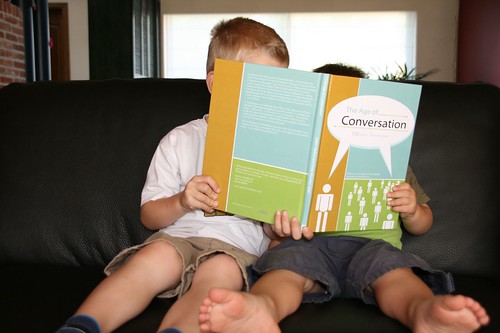
I won’t dwell on the fact that we intentionally make students do thoughtful work and then release the work into some digital outer space, never to be heard or read again. That IS what happens to Blackboard discussion forums. I’ll even play the devil’s advocate and say, “Hey, who cares? Conversations only happen once and then they are over, right?” That’s what my daughter tells me too. “Dad, it’s over. Can we move on?”
But wait, what about the conversations we do have and revisit? The conversations we have had where we think, years later, “Yeah, I learned talking to her/him.” Or those conversations that are timeless and weave their way throughout our lives as new connections are discovered or once grand thoughts are thrown away. Can we keep at least some of those in our pockets? In our diaries? In our yearly performance review reflections? Our sock drawers?
For better or worse, in a digital landscape things can be saved. Ideas can be recalled. Conversations can be revisited and even reborn. Not just any conversations, but YOUR conversations. Conversations you initiated or conversations you just took a part in. One of the things that computers and the internet do well is remember stuff. So finding these conversations becomes something that may be useful. And again, I’ll play the devil’s advocate and note that there are many conversations you’ll never want to revisit. There are some you will even want to forget. But like your memory, the internet just might keep those too.
So where did I put that conversation? Well, maybe it is in Facebook. There are great conversations that happen on Facebook. They are usually not the ones about ham versus turkey sandwiches or the ones about the night you… But there are amazing conversations about remembering friends or family who have passed on, or childbirths or amazing people doing amazing things. Where else might these conversations live?
The blogs right here in our 9x9x25 Challenge is one place. They serve as a place to see what you have thought and as a way to document where you have been and where you may be going. That is one of the topics I really hope gets moving in education land. You know, the one where teachers are continually demonstrating that they are doing better things than they used to do. And not just demonstrating the improvement in classrooms, but sharing the success and failures with their colleagues. If we all did have the time, if we did have the skills, what would a year of professional growth or progress look like if it was written in sentences?
Anyway, what about those digital conversations that are kept and stored on that thing called the internet? Maybe the comments on a piece of writing are mostly just encouragement and a positive bit of applause for your post like this from the amazing George Couros. That is good right? A little encouragement never hurts.
Maybe the comments are a deep discussion about a tool used in education like this one on Jim Groom’s blog. That conversation, by the way, is all about exactly what is happening in our 9x9x25 challenge and the digital architecture that is happening on the TeLS Webletter.
Maybe it is a bunch of educators having conversations about teaching and learning like those participating in this one. Maybe other teachers, like yourself, who would have never known of this conversation can now ponder some of the ideas expressed? At least the door is open.
Whatever the tool, whatever the topic, and for whatever audience, the internet does allow us to have and hold ideas in a way that could be useful to others and even to ourselves. You know, like those times you think, “What was it I said?”